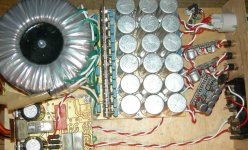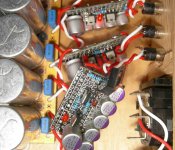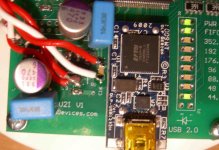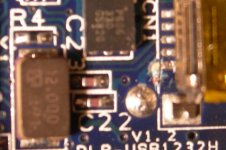I do not understand how you can isolate your analog output from the host computer by leaving the USB data lines connected but replacing only the USB power lines. The exaU2I only connects data to the DAC board and already has an external power supply input. There is no need to improve the USB power since it isn't used for the DAC board anyway.Is this something you have learned, been told or have you experienced it by yourself ?
As far as I am concerned, you could just as easily say that replacing the header connector improved the sound, and I wouldn't believe that, either.
Considering that there are already over three hundred replies in this topic, I think it would be helpful to stick to discussing the exaU2I. If you want to talk about some other receivers, nobody is stopping you from starting a new topic where your concerns can be more directly addressed.i am talking about some receivers, which i quite clearly mentioned probably did not apply here due to the nature of the device, as some effort has already gone into the supplies and it is not a traditional receiver.
I do not understand what you are trying to say. "Some receivers" cannot act differently than others. The USB Specifications define a particular way for power and resistor pull-ups to signal Device speed. But this is not an ongoing signal - it only exists during connection and must be removed before data can flow between the host and device because the same data lines are used. Granted, if you replace the USB power with an alternate source, then you have to make sure that you apply power first and then connect data, but USB is designed for power before data.some bus powered usb-spdif/i2s receivers do indeed use the ground and 5v power lines along with cable impedance and a resistor network to negotiate what speed is to be used and to make sure there is in fact a device there to send data to, replacing it with another 5v supply will do nothing in this circumstance, it will simply wonder where the device it is still connected to has gone. other ways around it may be found of course, but the above is not it
I am talking to anyone who thinks they can improve the exaU2I but futzing around with the digital supplies. The exaU2I already has galvanic isolation and external power for the I2S interface to the DAC. If anyone can prove that noise from the USB power makes it across that protection, then I'm sure they would be able to prove that the USB data itself causes an equal amount of noise. There is no way to sever the data lines, and they carry a higher signal level than the power lines. Unless someone is saying that the isolation chips are flawed, I don't see the point. Where are the measurements? Anyone can make claims that an elaborate sacrifice of chickens made their DAC sound better, but I'd like to see the schematic and an knowledgeable explanation of why it works better.huh..... who are you talking to?
I am talking to anyone who thinks they can improve the exaU2I but futzing around with the digital supplies.
Is this something you have learned, been told or have you experienced it by yourself ?
(I understand it may be hard to answer only the question asked, but please at least try)
Last edited:
None of the above. Your multiple choice question falls under the logical fallacy of Plurium Interrogationum.Is this something you have learned, been told or have you experienced it by yourself ?
(I understand it may be hard to answer only the question asked, but please at least try)
I am a scientist, not an alchemist. When someone like yourself claims to have made an improvement, I consider it to be subject to the test of the scientific method. First, you have to present at least some theory as to why your improvement works. Second, your improvements need to be duplicated by someone else outside of your 'laboratory.' Basically, your claims are considered false until proven by peer review.
You seem to be challenging me to disprove your claims, which is the opposite of the scientific method.
Tweaking of the exaU2I part 2 - pictures part 1..
The attached pictures shows the power supply and the JFET regulators..
In this prototype version I implemented the JFET regulators in the simplest / easiest way possible.
When the exaU2I are mounted inside the DAC cabinet there are already a main LifePO4 battery power and a two stage JFET regulator ready for connection of the exaU2I, and one stage JFET regulators will be soldered directly to the exaU2I PCB to avoid the long wires used in the prototype build.
The attached pictures shows the power supply and the JFET regulators..
In this prototype version I implemented the JFET regulators in the simplest / easiest way possible.
When the exaU2I are mounted inside the DAC cabinet there are already a main LifePO4 battery power and a two stage JFET regulator ready for connection of the exaU2I, and one stage JFET regulators will be soldered directly to the exaU2I PCB to avoid the long wires used in the prototype build.
Attachments
None of the above. Your multiple choice question falls under the logical fallacy of Plurium Interrogationum.
I am a scientist, not an alchemist. When someone like yourself claims to have made an improvement, I consider it to be subject to the test of the scientific method. First, you have to present at least some theory as to why your improvement works. Second, your improvements need to be duplicated by someone else outside of your 'laboratory.' Basically, your claims are considered false until proven by peer review.
You seem to be challenging me to disprove your claims, which is the opposite of the scientific method.
No - I am NOT challenging you in any other way than to possibly get an answer in regard of your statements are based on your own experience or something you have learned / been told...
Tweaking of the exaU2I part 2 - pictures part 2..
The pictures shows where the USB power trace from the USB connector are cut, and where the new 5 volt are connected to supply the USB parts.
The quality of the pictures are not the best, but they will have to do.
On the exaU2I there are also two other places I have cut traces.
The PCB trace going from the 5 volt (USB) to the 3.3 and 1.2 volt onboard regulators and the PCB trace close to the 1.2 volt regulator and reconnecting it to be supplied from the 3.3 volt.
The pictures shows where the USB power trace from the USB connector are cut, and where the new 5 volt are connected to supply the USB parts.
The quality of the pictures are not the best, but they will have to do.
On the exaU2I there are also two other places I have cut traces.
The PCB trace going from the 5 volt (USB) to the 3.3 and 1.2 volt onboard regulators and the PCB trace close to the 1.2 volt regulator and reconnecting it to be supplied from the 3.3 volt.
Attachments
My statements are based on my general experience with electronics design, combined with my experience and research in the world of audio reproduction. I have designed several commercial USB Devices, and have a great deal of experience with live music recording and mastering. In contrast, I know very little about power amplifier design, but at least Papa can explain why his improvements work, and it always make sense based upon the laws of electronics.No - I am NOT challenging you in any other way than to possibly get an answer in regard of your statements are based on your own experience or something you have learned / been told...
In my opinion, it would take a serious amount of theory and experimentation to explain why changing the power supply on one side of an isolated circuit could affect the analog quality on the other side of the isolation. If such magical properties were capable of passing noise across an isolation point, then I do not understand why your power supply is immune. What is better about your isolation? Explain, please.
Also, for all we know, there are noise sources in your test setup which are not present anywhere else, and thus your assurances that your improvements are substantial may not ever be duplicated elsewhere.
My statements are based on my general experience with electronics design, combined with my experience and research in the world of audio reproduction. I have designed several commercial USB Devices, and have a great deal of experience with live music recording and mastering. In contrast, I know very little about power amplifier design, but at least Papa can explain why his improvements work, and it always make sense based upon the laws of electronics.
In my opinion, it would take a serious amount of theory and experimentation to explain why changing the power supply on one side of an isolated circuit could affect the analog quality on the other side of the isolation. If such magical properties were capable of passing noise across an isolation point, then I do not understand why your power supply is immune. What is better about your isolation? Explain, please.
Also, for all we know, there are noise sources in your test setup which are not present anywhere else, and thus your assurances that your improvements are substantial may not ever be duplicated elsewhere.
The difference from the standard setup of the exaU2I in audio quality are in my setup as big as day and night, but I also know that in many so called High-End setups there may not be possible to hear any significant differences..
At least it is good to know that you have a commercial angle to this and not DIY...
You certainly succeed in giving the impression that the "standard" exaU2I is of modest quality and that tweaking it like you did is a must. Or that the rest of your system compares to other "high-end" ones like day and night.....The difference from the standard setup of the exaU2I in audio quality are in my setup as big as day and night, but I also know that in many so called High-End setups there may not be possible to hear any significant differences..
Clearly you think very highly of your system, and are proud of being the first to "publish" a major DIY haul-over of the exaU2I.
To me all this begs for a huge placebo effect that is likely to render your evaluation of the sonic benefits largely unreliable.
But then again I'm just a stupid scientist....
You certainly succeed in giving the impression that the "standard" exaU2I is of modest quality and that tweaking it like you did is a must. Or that the rest of your system compares to other "high-end" ones like day and night.....
Clearly you think very highly of your system, and are proud of being the first to "publish" a major DIY haul-over of the exaU2I.
To me all this begs for a huge placebo effect that is likely to render your evaluation of the sonic benefits largely unreliable.
But then again I'm just a stupid scientist....
You said it
As of my system I am satisfied with the results and it plays music..
I have stated it previously and here it is again:
The difference from the standard setup of the exaU2I in audio quality are in my setup as big as day and night, but I also know that in many so called High-End setups there may not be possible to hear any significant differences..
The "standard" exaU2I are certainly up to the commercial standards,
and if you are not a owner of a exceptionally well performing system there are most possibly little or nothing to gain by tweaking the device.
In a previous posting Leif Christensen hooked up the "standard" exaU2I and it outperformed his JKeny battery modded M2Tech Hifase.
And yes I am also familiar with Mr. Placebo as he certainly have played some "tricks" on me during the years
No "tricks" with Mr. Placebo. He is very much for real and reliableAnd yes I am also familiar with Mr. Placebo as he certainly have played some "tricks" on me during the years
Furthermore as the effect is directly proportional to the cost the most fortunate of us can simply choose the desired level of improvement!
Please explain how commercial experience and DIY experience are mutually exclusive.At least it is good to know that you have a commercial angle to this and not DIY...
Papa himself runs Pass Laboratories, with some of the most expensive amplifiers I have ever considered buying, and at the same time he gives away parts and enclosures to others when his own DIY interests turn to different places.
How can you say that I am not DIY?
Your postings sound a lot like you're trolling. In one message you claim that you produce gold-plated PCB designs and only use gold wire because it is the best. Then in another message you admit that you've never tested the exaU2I with gold, but rather mere copper and silver. Are you even aware that copper is a better conductor than gold? Why would you make a PCB out of gold traces for audio? Silver would be better. But for connectors that do not have solder resist protecting them, gold is better because is resists oxidization better. But be certain that gold is not better for everything just because it is more expensive. Gold is significantly less conductive than copper and silver.
Agreed. Also, consider that cost for one person might be dollars, while for another person it might be their time invested in some custom, hand-made 'improvement.' Placebo works whenever you believe something will be true.No "tricks" with Mr. Placebo. He is very much for real and reliable
Furthermore as the effect is directly proportional to the cost the most fortunate of us can simply choose the desired level of improvement!
I would expect it to outperform Leif's modded Hiface - the EXA is I2S & the Hiface that Leif has is a MK1 & outputs SPDIF.In a previous posting Leif Christensen hooked up the "standard" exaU2I and it outperformed his JKeny battery modded M2Tech Hifase.
Let's try to be rational and constructive. In the exaU2I original design power lines are optimized and cleaned according to the acceptable industry standards. Calculations, simulations and measurements tell us that whatever is on the board is more than enough to power digital circuits.
RayCtech's point of view is different. There are 3 groups of power lines on the board and RayCtech is trying to feed them with 3 independent close to ideal close to infinite power sources. In theory this will reduce jitter and common noise, since switching load in one group of digital components will not modulate switching timing in another set of components. According to his experience there is audible difference and RayCtech is proud to pioneer this experiment and to share it with us.
I'd like to point out that I am unable to detect -150 dB differences. I had hard time to believe that RayCtech can hear the difference between the modified and the original ASIO driver. So I played a trick on him. I produced a driver with mixed up control panel. RayCtech came back to me and said that the new version is garbage. There was a correlation of RayCtech's listening conclusions and the picture of the digital stream on my oscilloscope. (Yes, you can see LSB extension on and off with oscilloscope)
By no means this experiment is scientific or conclusive. However I feel great respect for the golden ear capabilities of the people from Norway. It is no coincidence that 2l - the publisher of 22 DXD albums is in Norway and that by far the biggest market for exaU2I devices is Norway.
There are two groups of people on this thread. Group one is made of people that are open to innovation and are prepared to invest their time, money and reputation to continue the innovation the way that is fun for them.
Group two have occupied 80% of the space on this discussion to prove that exaU2I does not exist, has no chance for success, has no business model, cannot be used because it is not perfect and cannot be made more perfect, has better and cheaper alternatives, can not be fun because if so many people said it is not fun without trying it, and without Mac drivers it is not even cool and no match for Titan.
I have always been a DIY person and I enjoy infinite power supplies. And I also truly enjoy roller-bearings for volume knobs and self-propelled speakers. I am jealous that someone else did them before I did. The stage for the next experiment is set - superconductivity and liquid-nitrogen cooling for ZERO jitter experience .
.
RayCtech's point of view is different. There are 3 groups of power lines on the board and RayCtech is trying to feed them with 3 independent close to ideal close to infinite power sources. In theory this will reduce jitter and common noise, since switching load in one group of digital components will not modulate switching timing in another set of components. According to his experience there is audible difference and RayCtech is proud to pioneer this experiment and to share it with us.
I'd like to point out that I am unable to detect -150 dB differences. I had hard time to believe that RayCtech can hear the difference between the modified and the original ASIO driver. So I played a trick on him. I produced a driver with mixed up control panel. RayCtech came back to me and said that the new version is garbage. There was a correlation of RayCtech's listening conclusions and the picture of the digital stream on my oscilloscope. (Yes, you can see LSB extension on and off with oscilloscope)
By no means this experiment is scientific or conclusive. However I feel great respect for the golden ear capabilities of the people from Norway. It is no coincidence that 2l - the publisher of 22 DXD albums is in Norway and that by far the biggest market for exaU2I devices is Norway.
There are two groups of people on this thread. Group one is made of people that are open to innovation and are prepared to invest their time, money and reputation to continue the innovation the way that is fun for them.
Group two have occupied 80% of the space on this discussion to prove that exaU2I does not exist, has no chance for success, has no business model, cannot be used because it is not perfect and cannot be made more perfect, has better and cheaper alternatives, can not be fun because if so many people said it is not fun without trying it, and without Mac drivers it is not even cool and no match for Titan.
I have always been a DIY person and I enjoy infinite power supplies. And I also truly enjoy roller-bearings for volume knobs and self-propelled speakers. I am jealous that someone else did them before I did. The stage for the next experiment is set - superconductivity and liquid-nitrogen cooling for ZERO jitter experience
Hi all,
I have news. I've just low passed one of the DXD files I was having troubles with and guess what, no noise/hiss anymore!
So I guess my little theory was right, what I am hearing is the effect of passband noise due to the shape of the low pass filter used in DXD files.
No I bet the reason the Buffalo DAC is not troubled is because it has some low pass filters somewhere in there.
For example AK4396 also has a digital filter, only that it is -6db at 96Khz for a sampling rate of 96Khz. And that is for the "sharp" roll-off setting
The filter I applied in Audacity was 20,000 Hz, 24db. Unfortunately that is not practical, I need to experiment with values higher than this, however for the purpose of experimentation it worked great.
I will try to load the dxd files and the 352.8k "clean" files I have in a visualization software to see if I can further confirm the noise content idea.
I have news. I've just low passed one of the DXD files I was having troubles with and guess what, no noise/hiss anymore!
So I guess my little theory was right, what I am hearing is the effect of passband noise due to the shape of the low pass filter used in DXD files.
No I bet the reason the Buffalo DAC is not troubled is because it has some low pass filters somewhere in there.
For example AK4396 also has a digital filter, only that it is -6db at 96Khz for a sampling rate of 96Khz. And that is for the "sharp" roll-off setting
The filter I applied in Audacity was 20,000 Hz, 24db. Unfortunately that is not practical, I need to experiment with values higher than this, however for the purpose of experimentation it worked great.
I will try to load the dxd files and the 352.8k "clean" files I have in a visualization software to see if I can further confirm the noise content idea.
rsdio, it is only you that turned this into something anything ore than it was, a remark in passing that i said right there in that first post would not effect the exa unit, i should have just ignored you when you still picked it out as something to argue with based on what your books tell you. it is clear that you simply believe in perfect models and specifications without loopholes that everyone complies to. anyway i'll leave you to your distraction, this is more fun sitting back watching at the moment anyway 
Last edited:
I agree with qusp that exa065's post is probably right on the spot. Even if the need for OSX drivers for me is an absolute pre-requisite and not a "cool feature" of the deviseLet's try to be rational and constructive.
So while waiting for these drivers maybe a hardware exaU2I V2 will be become available and just maybe we could have some influence on possible new features.
As I also like supply upgrades I would like to see headers and jumpers which could be used for easy and reversible bypass of the on-board supplies.
Cheers,
Nic
- Home
- More Vendors...
- exaDevices
- exaU2I - Multi-Channel Asynchronous USB to I2S Interface




 that was a very well handled post
that was a very well handled post